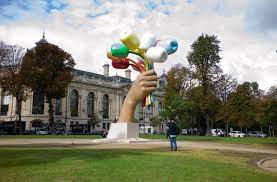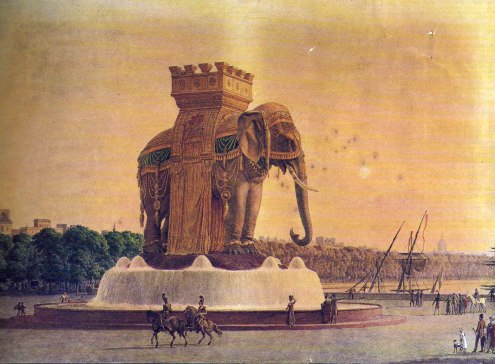|
| Ugliest Buildings in
Paris (#3) |
|
Competing buildings:
|
|
|
|
Paris is a magnificent city and, once again in 2015, it was the most visited city in the world, right before London. There is no need on this site to show pictures of beautiful buildings : you can see them everywhere.
| The dramatic fire of Notre-Dame cathedral in April 2019 (see the major steps of its restoration since the date of the fire), raised once again the traditional question : "Can we mix a modern design with an old building or would it be a crime against our heritage ?" Here below are a few examples, most of them ugly, but not all ... |
|
|
However, some of its new buildings are particularly ugly and it seems fair to show them and try to explain how it was possible to build such an ugly bulding in such a beautiful city. So I have created two contests : one is the Ugliest Building in Paris Contest (UBPC), the other is the Most Controversial Building Contest (MCBC).
In addition to ugly buildings, the current policy of the City of Paris is very controversial and generates very ugly equipment all over the city : read more. |
| My nominees for the Ugliest Building in Paris Contest ... |
Folly ! (see Right)
- On the left of the picture, an 18-century-old wall, the wall of the Roman bath of Lutece (before the city became Paris) : light grey stones and red bricks lines
- in the back of the picture, a giant imitation of a facade, made of cast aluminium, painted in a color to make it very visible and, of course, totally different from the color or the Roman walls around : it is the entrance hall of the museum
- Who had the idea of this design, in one of the most romantic parts of the Latin Quarter ?
|
|
|
A nonsense ! (see Right)
-
The Rond-Point des Champs-Elysées is the very beginning of the famous avenue, close to the Elysée palace and the Grand Palais. Six mysterious objects have been built around it in April 2019. What are they : derricks? scafholdings? No : they are monumental fountains (40 ft. high) designed by two French artists ; they are made of bronze and crystal and in the picture you can see the water falling down, like from a kitchen tap. The three taps turn slowly and scintillate at night. Nobody notices them because they look like temporary poles but when they understand that they are works of art, people crack up.
-
These fountains are part of the mayor of Paris' program to change the aspect of a tenth of its major crossroads. She succeeded : it is a dramatic change.
|
|
|
|
|
|
A provocation ! (see Left)
-
This Stalinian-looking building was built in the 1960s, along the river, 17 boulevard Morland, in the 4th Arrt. As you can see, the style of the building is that of an official building in the former Soviet Union and it is much higher (about twice) than the typical Hausmannian buildings which make the charm of Paris (7 floors, slate roof, made of light-yellow stone) as you can see on the buildings between our nominee and the river. The land-use plan in Paris is very strict maintaining about as much homogeneity as possible, to keep a soft "velum" with no building higher than 7 floors, etc.
-
Therefore, you may wonder how it is possible that such a building has been built, in spite of this very strict regulation, enforced by thousands of civil servants. You don't have a clue? I can give you the answer : the building is the headquarters of Direction de l'Amenagement et de l'Urbanisme (Department of Architecture and City Planning) of the City of Paris which is in charge of giving (or not) building permits, in respect to the Land Use Plan that it is in charge of enforcing. Funny, insn't it?
-
For this reason, it deserves to be nominated for the UBPC.
|
A mistake ! (see Right)
-
The Opera Bastille, place de la Bastille in the 4th Arrt., was one of the monuments built under President Mitterrand in the 1980s. Contrary to the "old" Opera House, built in the 1860-1870s, which can be considered one of the most beautiful buildings in Paris, this one is heavy, with no grace, nothing very attractive in its form. The acoustics are good and the opera succeeded in its main objective which was to make opera-going easier and cheaper for the Parisians.
-
Still, its form is not elegant and the story goes that after it was short-listed (anonymously) in an international competition of more than one hundred projects, this project reminded the jury very much of the style of a very famous and excellent architect that the President admired and it was chosen for this reason.The President was very disappointed when he discovered that the winner was the first project of a young and unknown Uruguayan architect. It deserves to be nominated for the UBPC.
|
|
|
|
|
A ridiculous building for the Ministry of Culture ! (see Left)
-
The existence of a Ministry of Culture is one of the French specificities and it is located in the delightful 18th Century building of the Palais Royal, near Le Louvre. Its offices are in the adjoining block in a rather banal 19th Century building. A crazy Minister of Culture (some of them are) decided to improve this banal building with a steel construction all around it. Disguised like that, it looks like a giant lump of noodles.
-
This is the result, which, in my opinion, is worth a nomination for the UBPC.
|
An airport roof in the middle of Paris ! (see Right)
-
The "canopee" (canopy) of Les Halles is one of the most absurd ideas an architect can have in a historical center, in front of one of the most beautiful churches of Paris : a more than four-acre steel and glass roof, a very strange color, with a name wrongly suggesting nature and a reality which is a mere mineral airport roof. The project was finished in 2016.
-
The Mayor of Paris, Bertrand Delanoe, and his successor, Anne Hidalgo, wanted this very costly project to be an artistic symbol of their mandate. Failed.
-
For this reason, it deserves to be nominated for the UBPC.
|
|

(credit) |
 |
|
An aluminium building next to an 18th century mansion ! (see Left)
The Banque Postale (the banking subsidiary of the French Post Office) owns a block on fancy Rue de Sevres Paris 6th, including the delightful 18th century Hotel Choiseul Praslin.The bank decided to built its own headquarters in this strange steel building which, in my humble opinion, does not add anything to its predecessor ... |
A huge kitsch monument between the Champs-Elysées and the Seine river (see Right)
- The famous US artist Jeff Koons has "offered" this sculpture (financed by sponsors) to the City of Paris on the condition that he would choose the place to put it : right in front of the Museum of Modern Art
- Instead of bluntly refusing this unwished gift, the City proposed another site, less visible, behind the (pretty) Petit Palais and the artist accepted it after long negotiations
- The project and the demands of the artist raised a big controversy and most Parisians hate it (my humble opinion : it is ridiculous...)
|
|
( credit) credit) |
| More to come ...... |
|
Potential other candidates for nomination : Tour Montparnasse, Tour Jussieu, Grande Bibliotheque, ...
|
| My nominees for the Most Controversial Building Contest ... (in the past) |
|
In the past, some buildings have raised huge controversies but, more or less rapidly, they found their place in the Paris landscape and most people love them. This is the case of the Pei Pyramid of the Louvre or the Grande Arche de la Defense. Others less so and many people still hate them. I have designed a special contest for the Most Controversial Buildings! |
|
|
-
The Sacre Coeur Basilica, on the hill of Montmartre, was built from 1875 by national subscription, after the bloody revolution of a pre-Communist revolution 1871 ("la Commune"). The new Regime (the Third Republic) was extremely afraid of the revolutionary movement and the Bourgeoisie who had been seriously traumatized decided to build this giant piece of cake as "an expiation for the sins of La Commune". In my humble opinion, the inside is even worse that the outside.
-
Many French people hate it, some for esthetic reasons, some for political reasons, some for both. I hate it and I nominate it for the MCBC.
|
- When, in 1983, the Chinese-American architect Ieoh Ming Pei presented a glass pyramid as his project for a new entrance to the Louvre museum, it caused a huge uproar.
- After it was built, in 1989, its beauty and harmony with the museum convinced even its worst critics and there is no longer any controversy about it.
|
|
|
| More to come (this page is still under construction) |
|
Potential other candidates for nomination : The Eiffel Tower, Centre Pompidou, the facade of the Samaritaine Rue de Rivoli, ... |
| Monuments which were not built (fortunately) ! |
|
|
 (credit) (credit) |
|
This enormous triangle (called Tour Triangle) is one of the favorite projects of the current Mayor of Paris, Anne Hidalgo. It has been blocked several times by various courts but is still a terrible threat to the Paris skyline. |
A giant elephant in the middle of Paris !
After the storming of Bastille in 1789, the castle was destroyed.
In 1810, Napoleon decided to erect a giant elephant in bronze Place de la Bastille but, fortunately, he became too busy, with Spain first and then Russia, to build it. A plaster model was built instead and it was destroyed in the 1840s. Whew! |
|
 The giant elephant of the Bastille The giant elephant of the Bastille |

Paris in the future, as seen by Le Corbusier |
|
A line of skyscrapers instead of the Latin Quarter !
It is hard to believe but you can see (left) what the famous Franco-Swiss architect Le Corbusier proposed in 1930 to transform the center of Paris (the right of the picture is the island with Notre Dame cathedral).
Wow....
For French speakers : an excellent book about the history of the crimes against the French heritage, from the Middle Ages to today : Louis REAU, Histoire du vandalisme. Les monuments detruits de l'Art francais, Robert Laffont, 1994, 1190 p. |
|
|
|
|
| To related pages : more ugly Paris, see also unknown
Paris (#1), Paris notebook, historical landmarks,
places you can avoid, etc... |
|
To table
of contents
To top of the page
Back to home
page
|
For more on intercultural
differences, order Harriet Welty Rochefort's books :
- "Joie de Vivre", Secrets of Wining, Dining and Romancing like the French, St.Martin's Press, New York, 2012
- "French Toast, An American in Paris
Celebrates The Maddening Mysteries of the French", St.Martin's Press,
New York, 1999
- "French Fried, The Culinary Capers
of An American in Paris", St.Martin's Press, New York, 2001
More on Harriet's books (excerpts, upcoming
events, testimonials, etc..)
|
| To email
me |
If you like
this site, please bookmark it or create a link! |
|